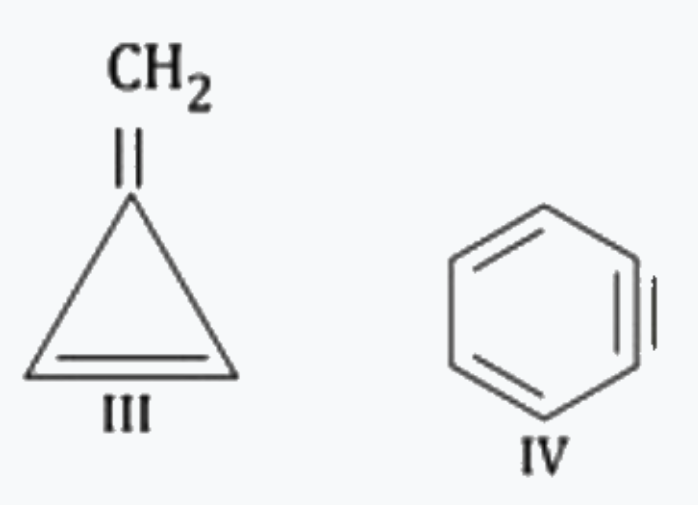In which of the following species, S-atom assumes sp3 hybrid state ?
(I) (SO3) ,
(II) (SO2) ,
(III) (H2S) ,
(IV) (S8).
I,II
II,III
II,IV
III,IV
The correct Answer is:D
To determine in which of the following species the sulfur atom assumes an sp3 hybrid state, we need to analyze each species one by one using the concept of hybridization and steric number.
1. Identify the Species: We have four species to analyze:
- (I) SO₃
- (II) SO₂
- (III) H₂S
- (IV) S₈
2. Calculate the Steric Number: The steric number can be calculated using the formula:
\(
\text{Steric Number} = \frac{1}{2} \left( V + M + C - A \right)
\)
where:
- \( V \) = number of valence electrons of the central atom (sulfur in this case)
- \( M \) = number of monovalent atoms bonded to the central atom
- \( C \) = charge on the molecule (if any)
- \( A \) = charge on the cation (if any)
3. Analyze Each Species:
- (I) SO₃:
- Sulfur (S) has 6 valence electrons.
- It is bonded to 3 oxygen atoms (considered divalent).
- Using the formula:
\(
\text{Steric Number} = \frac{1}{2} (6 + 0) = 3
\)
- Hybridization: sp² (not sp³).
- (II) SO₂:
- Sulfur (S) has 6 valence electrons.
- It is bonded to 2 oxygen atoms.
- Using the formula:
\(
\text{Steric Number} = \frac{1}{2} (6 + 0) = 3
\)
- Hybridization: sp² (not sp³).
- (III) H₂S:
- Sulfur (S) has 6 valence electrons.
- It is bonded to 2 hydrogen atoms (monovalent).
- Using the formula:
\(
\text{Steric Number} = \frac{1}{2} (6 + 2) = 4
\)
- Hybridization: sp³ (this is correct).
- (IV) S₈:
- Each sulfur atom has 6 valence electrons.
- In S₈, each sulfur forms 2 bonds with neighboring sulfur atoms.
- Using the formula for one sulfur atom:
\(
\text{Steric Number} = \frac{1}{2} (6 + 2) = 4
\)
- Hybridization: sp³ (this is also correct).
4. Conclusion: The sulfur atom assumes sp³ hybrid state in:
- (III) H₂S
- (IV) S₈
Final Answer:
The species in which the sulfur atom assumes sp³ hybrid state are (III) H₂S and (IV) S₈.
- (I) SO₃
- (II) SO₂
- (III) H₂S
- (IV) S₈
\(
\text{Steric Number} = \frac{1}{2} \left( V + M + C - A \right)
\)
where:
- \( V \) = number of valence electrons of the central atom (sulfur in this case)
- \( M \) = number of monovalent atoms bonded to the central atom
- \( C \) = charge on the molecule (if any)
- \( A \) = charge on the cation (if any)
- (I) SO₃:
- Sulfur (S) has 6 valence electrons.
- It is bonded to 3 oxygen atoms (considered divalent).
- Using the formula:
\(
\text{Steric Number} = \frac{1}{2} (6 + 0) = 3
\)
- Hybridization: sp² (not sp³).
- Sulfur (S) has 6 valence electrons.
- It is bonded to 2 oxygen atoms.
- Using the formula:
\(
\text{Steric Number} = \frac{1}{2} (6 + 0) = 3
\)
- Hybridization: sp² (not sp³).
- Sulfur (S) has 6 valence electrons.
- It is bonded to 2 hydrogen atoms (monovalent).
- Using the formula:
\(
\text{Steric Number} = \frac{1}{2} (6 + 2) = 4
\)
- Hybridization: sp³ (this is correct).
- Each sulfur atom has 6 valence electrons.
- In S₈, each sulfur forms 2 bonds with neighboring sulfur atoms.
- Using the formula for one sulfur atom:
\(
\text{Steric Number} = \frac{1}{2} (6 + 2) = 4
\)
- Hybridization: sp³ (this is also correct).
- (III) H₂S
- (IV) S₈
The species in which the sulfur atom assumes sp³ hybrid state are (III) H₂S and (IV) S₈.
Topper's Solved these Questions
- P-BLOCK GROUP 16 ELEMENTS - THE OXYGEN FAMILYBOOK - CENGAGE CHEMISTRY ENGLISHCHAPTER - P-BLOCK GROUP 16 ELEMENTS - THE OXYGEN FAMILYEXERCISE - Exercises (Linked Comprehension)
23 Videos
- P-BLOCK GROUP 16 ELEMENTS - THE OXYGEN FAMILYBOOK - CENGAGE CHEMISTRY ENGLISHCHAPTER - P-BLOCK GROUP 16 ELEMENTS - THE OXYGEN FAMILYEXERCISE - Exercises Multiple Correct
14 Videos
- P-BLOCK GROUP 16 ELEMENTS - THE OXYGEN FAMILYBOOK - CENGAGE CHEMISTRY ENGLISHCHAPTER - P-BLOCK GROUP 16 ELEMENTS - THE OXYGEN FAMILYEXERCISE - Ex 3.1 Subjective (Give Reason :)
14 Videos
- P-BLOCK GROUP 15 ELEMENTS - THE NITROGEN FAMILYBOOK - CENGAGE CHEMISTRY ENGLISHCHAPTER - P-BLOCK GROUP 15 ELEMENTS - THE NITROGEN FAMILYEXERCISE - Exercises Archives (Subjective)
28 Videos
- P-BLOCK GROUP 17 ELEMENTS - THE HALOGEN FAMILYBOOK - CENGAGE CHEMISTRY ENGLISHCHAPTER - P-BLOCK GROUP 17 ELEMENTS - THE HALOGEN FAMILYEXERCISE - True/False (Subjective)
14 Videos
Similar Questions
Knowledge Check
In which of the following reactions heterogeneous catalysis is involved?
(i) 2SO2(g)+O2(g)NO(g)−−−−→2SO3(g)
(ii) 2SO2(g)+O2(g)Pt(s)−−−→2SO3(g)
(iii) N2(g)+3H2(g)Fe(s)−−−→2NH3(g)
(iv) CH3COOCH3(l)+H2O(g)HCl(l)−−−−→CH3COOH(aq)+CH3OH(aq)
options- a). (i), (iii)
b) (ii), (iii), (iv)
c) (i), (ii), (iii)
d) (iv)A(i), (iii)B(ii), (iii), (iv)C(i), (ii), (iii)D(iv)
Which of the following species are hypervalent ?
(I)ClO−4 (II)BF3
(III)SO−24 (IV)CO−23
View SolutionIn which of the following, S shows an oxidation state of +6? H2S2O6, SO2−2, SO3, All of these
View SolutionArrange the following in correct order of acidity
(I) CaO, (II) SO2, (III) SO3, (IV) P2O5
View SolutionIn which species the hybrid state of central atom is / are sp3 d ?
View SolutionWhich of the following compounds have the same no. of lone pairs with their central atom?
(I) XeF−5 (II)BrF3 (III) XeF2 (IV)H3S+ (V) Triple methylene
View SolutionWhich of the following compounds have the same no. of lone pairs with their central atom?
(I) XeF−5 (II)BrF3 (III) XeF2 (IV)H3S+ (V) Triplet methylene
View SolutionWhich of the following structure contains sp - hybridized carbon atoms?
HC≡CHI H2C=C=CH2II
View Solution
